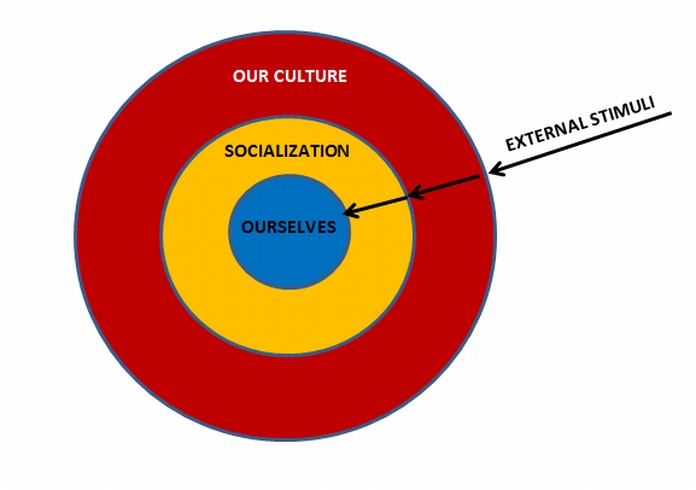Living At The Cultural And Technological Crossroad – An Intercultural Theory
Even though two people speak the same language, having come from different cultures, their understanding of the spoken language will be different.
An American, a Frenchmen and a Chinese, all owners of smartphones, found themselves in a locked room. Can you guess the outcome? No, really, this happened to me. Except that I was neither of them, belonging to a fourth nationality, the Romanian born South African.
Ah, South Africa! The “Rainbow Country”! The nation with 11 official languages where people from numerous cultural backgrounds live together in harmony and peace. Apart from the local Zulu, Xhosa, Sotho and Tswana to name but a few, we have Afrikaners, Portuguese, British, French, Dutch, Greeks, Italians, Romanians, and the list goes on and on. And no, we don’t communicate with each other in Esperanto but in English, mainly.
So what happened in this 21st century locked room mystery?
What are the consequences of bringing together folks from different cultural backgrounds during a dinner event in today’s modern times?
People using their smartphones throughout the course of the evening to send messages, connect to social media sites, surf the web or even play games; two out of five adults at my table, three out of seven at a nearby table, with various adults at neighboring tables joining them. And I doubt they were texting each other…
While I did my best to follow the proceedings of the evening a bothersome question nestled itself in my mind. Why would 20%-30% of educated individuals, coming from an array of cultural backgrounds, choose to ignore all rules of social mobile etiquette? What possessed them?
I believe that, leaving all social protocol aside, there are two theories behind this situation. Let’s deve into the cultural / technological theory.
1. The intercultural theory
People from different cultural backgrounds for whom English is not the first language, when communicating in English will lose important cognitive information, thus being in danger of drifting off and losing interest on the information presented.
Lost in translation
In other words, when two people coming from different cultural backgrounds and for whom English is not their mother tongue listen to an English sentence each one will perceive, will absorb and will relate to it in a different way; the information it carries being filtered through the listener’s own cultural background.

This is similar to the color perception theory which says that when two people look at the same color they will see two different shades of it, but they will never know how the two shades differ, or what shade precisely the other one perceived.
So many words, so little time
Fact: statistics show that out of 7 billion people in the world, 1,500 million speak English, of whom only 375 million are native speakers. That’s 21.4% English speakers in the world and only 5.36% English native. For the rest of 20% English speakers English is not their first language.
Research also shows that in the United States there is an increase in the decision non-English natives make to use their mother tongue at home, as opposed to English.
2. The technological theory
Living in the über-technological 21st century the use of one’s smartphone has evolved from need to compulsion. The smartphone isn’t a utility anymore, but an addiction. We don’t watch nature anymore, we take pictures of it. We don’t experience the Supermoon, we view it through our phone’s screen instead. We attend a live event, yet we look at it through our mobile screen, detaching ourselves from real life, extracting ourselves from present.
Putting things into perspective as opposed to living them
Let’s not point fingers yet, as each generation’s digital inclination will translate into a greater easiness for the following one in the use of digital technology as a learning tool. This means less paper used, less trees cut, more oxygen and less greenhouse effect, yes, one has to put things into perspective.
Fact: globally, in one second: there are 7 368 Tweets sent, 745 Instagram photos uploaded, 1 166 Tumbler posts, 2 300 Skype calls, 38 579 GB internet traffic, 56 616 Google searches, 132 753 YouTube videos watched, 252 9486 emails sent, 67% of which are spam.
Mobile phones are IN and they’re here to stay.
Now let’s take a closer look at these two theories.
1. An in depth look at the intercultural theory: living the dream or a cultural migration?
In a world in which political barriers are falling (the Berlin Wall in 1989, Communism in Russia and eastern Europe, the Arab spring), economic barriers are falling (the introduction of the Euro currency in 2002 and countries joining the EU group in 2004 and after) or are being rebuilt (Brexit, 2016), people choose or find themselves forced to live outside their natural geographic barriers, migrating or emigrating.
It is the birth of the cultural diversity and we live it.
Still, no matter how many barriers we remove, other barriers fall in place. How and why are these new walls influencing our lives?
Why are we faced with cultural barriers in communication?
We all share ideas, beliefs, traditions and rituals – to some extent. What differentiates an individual from the next are the bits and bobs that have been handed down by past generations. These form our national, ethnic, religious self, through which we filter the outside world to, eventually, understand it and interpret it. It is our culture; it helps us understand the reality, make it our own and thus finding our place in the world. It is what makes us feel “at home” on an emotional level.
Everything we’ve inherited from our parents and from our immediate community will shape the way in which we understand and cope with reality. The culture inherited through our mother-tongue especially, as it is our second skin, our air bubble, our personalized atmosphere. It reshapes our brain thus filtering the way we perceive the reality. It influences our thoughts and behaviors, because different languages have different social realities. Even though two people speak the same language, having come from different cultures with different mother tongues, their perceptions and understanding of the spoken language will be different.
Culture as an air bubble
Take the Americans, for example. They’re used to communicate freely. Germans are known to be direct, Hispanics love physical closeness during a conversation, while for Indians being indirect while they communicate with each other is a way of life.
This is why cultural diversity can cause people speaking the same language to distance from each other; not on a physical level, but an emotional one. The culture we grew in will influence the way we think and communicate with others, our expectations and, at times, these factors can become barriers.

Think of the expat communities formed all over the world, the China-Towns, the Russian congregations, the Spanish communities or the Harlem. People share a need to be among like-minded, like-cultural, like-mother-tongue speakers. Among people who think along the same principles, share the same humor and understand the subtitles of each other’s body language. (The Sapir-Whorf Hypothesis, 1958-69)
Example: Time as it is viewed by different cultures
Internationally renowned linguist Richard Lewis explains how different cultures understand time.
Think of the word “time” and its English connotation. We associate it with “money” therefore we say that time can be “spent”, “saved”, “wasted” or “invested”. This linear vision of time is shared by the Anglo-Saxon world and the same goes for the Swiss, which turned precision and being on time into a national symbol. For them, time is an abstract commodity valued by what one CAN DO with it before it runs out. It is also a source of constant stress. Hurry, it ticks.
Now think of the southern and eastern Europeans, the Italians, Portuguese, Turks or Arabs. For them, WHOM you share your time with is much more important that the passing of the time itself. Finishing a conversation happening in present time is more important than cutting it short because of being late for a future appointment. Because “now” I share my time with you; now is enjoyable, therefore it is more important than a forthcoming appointment. To them, time is a personal commodity valued by HOW IS one enjoying it – therefore not worrying since there is plenty of it anyway; time stretches out ad infinitum. Relax, it pulses.
For Asians, time goes around in a CIRCLE. Time must be observed from all perspectives before deciding which tasks are important and which ones needn’t worry about. At the same time, the other person’s time is seen as more valuable than their own time. To them, FOLLOWING TRADITIONS is more important than the actual passing of time. Think & meditate, it hums.
But be it American, Italian or Chinese, time and the way one relates to it, understands it and refers to it has a specific meaning, passed through generations and through their mother tongue; filtered by their culture.

2. Looking at the technological theory: living in the über-connected 21st century
Today’s younger generation is the first one ever not to know what life was like without a cellphone.
Gulp
While our generation, the 40’s something, grin, is the last one to have experiencing life with a corded phone. A fixed phone with a rotating disc and a receiver attached to the phone by a spiral cord. And a chair nearby for those long distance conversations that could only happen at home, at work or in a phone booth – but in no other place. And, yes, some of these conversations were kept private and for good reason. Our generation is the last one to be able to tell stories about the neighbor’s ebonite phone resonating “tir-tir, tir-tir” all the way from the upstairs’ apartment.
Sigh
Only 500 years ago the Renaissance Man was both a scientist and an artist, a mathematician and an astronomer; an all-rounded scholar. His thirst for knowledge was insatiable. But knowledge had to be investigated and conquered. The reward had to wait.
Nowadays our neophilia, our need for novelty, is but a click away, a swipe of finger across the screen; right at our fingertips, rewarding in its promptitude but also exhaustingly hyper-stimulating.
Rewarding.
It is normal for the human race to crave rewards. Rewards are what fuels progress and humans have a physical need to experience rewards because they release dopamine in our brains. Whenever a pleasurable experience happens, a surge of dopamine, a neural chemical, is being released into our brain. We feel good and as a result we want to repeat the behavior. And the “dopamine pathway” is being reinforced. But drugs or other activities which produce instant pleasure, like over-texting, hijack this pathway becoming addictive.
Mobile phones, a reward or an addiction?
We post a comment and we get a Like. Happy! What’s our brain thinking? I’ll do it again! Click, click, click – happy, happy, happy!
We have a question, do a quick internet search and find the information needed. Happy! “Cool, new stuff,” thinks Brain! “Let’s do this again, soon!”
It’s easy to understand why over-texting and neophilia can be seen as a reward, thus becoming addictive.
Is it really this simple or is there MORE to over texting? Are we all the same, being conditioned in the same ways or is there MORE to it? A silent, underlying layer.
Example: Over-texting and its real life implications
A 2010 study done by scientists at Case Western Reserve School of Medicine on texting habits of 4 257 high school students discovered that 20% of them were over texting (sending over 120 texts/day). These teenagers were termed as “hyper-texters”. Teenagers who spent three or more hours/day on social networking sites were termed as “hyper-networking”. Study showed that the “hyper-texters” were twice more likely to have tried alcohol, 41% more likely to have used illegal drugs, and 3 and half times more likely to have had sex. Think it’s a lot? Wait, the “hyper-networkers” were at an even higher risk.
Today’s younger generation is fully immersed in social media and technology. But they are also the first generation to suffer a decline in face-to-face communication. The first generation to be disconnected from real life… because they are connected to an electronic device. A generation of faces lit in the dark only by the screen of a cell phone, the “glow kids” as Dr Nicholas Kardaras Executive Director of the Dunes, one of the world’s top rehabs, calls them.

It is a mobile-social generation on the rise, but with a worrying decline in social skills.
Warning: the physical social disconnection caused by over-connection to social media had been linked to an increase in depression cases across teens and adult in present days compared to 1980.
The mobile phone relationship: are you ready to go steady?
Look at your cell phone. How often do you use it? How much do you rely on it? Was it by choice or not? Are our mobile phones available to us OR are we available to them because we never switch them off? Ask yourself, who’s using who?
In the present world, with information and communication so easily accessible, with 9/10 American owning a cell phone (2015) are we really the owners of this advanced technology-or is IT owning us?
Cell phones are hugely utile and they give us freedom, but at the same time they enslave us, tying us to our social contact lists. We feel that we can’t postpone replying to a message because we see the sender shows online and we know that he, too, can see us online. We can’t leave the work issues at work-they come following us, beep-ing from the bedside table in the middle of the night or over the weekend.
Our mobile phone’s constant availability is no longer an advantage but a social expectation as our contacts assume we’re at their disposal 24/7 and, to be honest, so do we of them. In 2015 90% of Americans frequently carried their cell phone with them! No wonder a mobile phone has more germs on it than a toilet seat.
But our “mobile” availability has become a constant source of stress too. What freed us has also enslaved us.
The palpable reality is: our mobile phones own us. Sounds like the title of a B-rated horror movie, isn’t it? “Owned by the Mobile Phone!” evil laugh
What’s worse is that we are constantly being programmed to depend on our mobile devices. What are the chances of you landing a good job without owning a cell phone? What are the chances of making an emergency phone call without a cell phone? In 2015, 43% of American adults lived in a cellphone-only household.
Cell phones are a benediction and a spell. An instant connection and an endless interference.
Surfing the technological wave
So, is over cellphone usage an addiction, a mere social behavior or just part of the 21st century?
The number of world’s cell phone owners is expected to exceed 5 billion by 2019, siting at 4.61 billion in 2016. A PEW research conducted by Andrew Perrin shows that in 2015 90% of American young adults (ages 18 to 29) used social media compared to only 35% in the 65 years and older group. Internationally the numbers are comparable with the Germans leading by 86% followed by Britain with 81%, and France with 78% of their young adults using social networking sites and only 8% of adults over the age of 50 years old (16% in Britain, 13% in France), as shown in a 2010 PEW research.
Signs and Symptoms of Cell Phone Addiction
Are you addicted to your smartphone? How brave are you? Take the self-assessment test.
Love thy neighbor
The inter-cultural communication can raise barriers but it can also be an opportunity for opening ourselves to new view-points, new prospects, and more harmony in the world.
How to overcome the cultural distance
- Actively, willingly, by making an active effort of understanding each other and the cultural direction we both arrive from. By accepting that there might be a difference of view, yet willingly trying to understand in what this difference consists.
- Emotionally, by being emphatic towards one another and choosing to overcome stereotypes. By actively understanding and being prepared to open ourselves to the other’s culture.
- Academically, by choosing to be present in the moment and absorb the information we are being offered.
Marco Polo lived among the Chinese, absorbed their culture and brought back invaluable lessons and inventions. Christopher Columbus inaugurated centuries of European exploration in the Americas.
Choose real, not virtual
In the long run, is the social connectivity really paying off?
British anthropologist and evolutionary psychologist Robin Dunbar, now teaching at Magdalen College Oxford, is the author of How Many Friends Does One Person Need? Dunbar said: “We’re members of the primate family – and within the primates there is a general relationship between the size of the brain and the size of the social group. There are social circles beyond it and layers within – but there is a natural grouping of 150.”
150, Dunbar’s Number
A person can only have 150 acquaintances, but ONLY 5 close relationships. Because it is more difficult, although more significant and extremely rewarding to have fewer close relationships then lots of online followers.
Because, how Dundar puts it, “we actually have to get together to make a relationship work. In the end, we rely heavily on touch and we still haven’t figured out how to do virtual touch. Maybe once we can do that we will have cracked a big nut. Words are slippery; a touch is worth a 1,000 words any day.”
Okay, you don’t have to hug your boss
Dunbar goes further with his explanations and this is something each new parent discovers, sooner or later… the sooner the better. Pick up a crying baby and chances are he will stop crying if you keep holding him, caressing him. And no, you’re not spoiling him.
The same principle is valid for human relationships.
The mammal’s skin has a huge amount of neurons that respond to light touch, but not to any other kind of touch. Light stroking triggers endorphins, also responsible for our happiness by reducing pain and stress. In the dolphin world, calves brush their bodies against their mothers, this helping to strengthen their bond as well as their social ties. The same result happens when primates groom each other. Humans are mammals too.
Sadly, as yet, social media does not include touch therefore it is not real human bonding. It has the opposite effect, destroying the natural paths of human interaction of which touch and physical contact are important – creating the “illusion” of connection.
But everybody’s doing it
Texting during meetings or social events, chasing up Likes and Followers on social media, yes, everybody’s doing it. Just remember that YOU are an individual. Like your mom always told you: “If your friends jump off a cliff, would you jump too?!”
Humanity survived and moved forward for over two millennia without the interference of mobile technology. Yet only twenty years of cellphone usage has already produced its first generation of possible social failures.
The way forward is by retracing the steps of history, learning from mistakes and bettering ourselves.

Change begins now
The question that lies ahead of all of us is: has the moment when we need to learn from these past 20 years of mobile technology mistakes arrived yet? Is it NOW that we must remind ourselves we are humans and technology is but a tool invented by us, to use as WE please-and not vice-versa?
And no, the answer to this question does not lies at the end of a search engine.
wink
A 1000 words extract from this article about the cultural – technological theory was published on Huffington Post South Africa and is now available on the Huffington Post UK.
I hope you found the cultural – technological theory interesting. What are your houghts?
You might also like:


One Reply to “Living At The Cultural And Technological Crossroad”
Comments are closed.